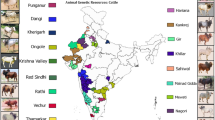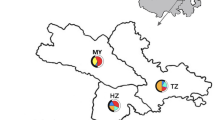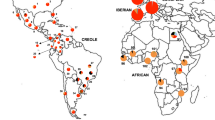Abstract
To determine the Y chromosome genetic diversity and paternal origin of Chinese cattle, 369 bulls from 17 Chinese native cattle breeds and 30 bulls from Holstein and four bulls from Burma were analyzed using a recently discovered USP9Y marker that could distinguish between taurine and indicine cattle more efficiently. In total, the taurine Y1, Y2 haplogroup and indicine Y3 haplogroup were detected in 7 (1.9 %), 193 (52.3 %) and 169 (45.8 %) individuals of 17 Chinese native breeds, respectively, although these frequencies varied amongst the Chinese native cattle breeds examined. Y2 dominates in northern China (91.4 %), while Y3 dominates in southern China (81.2 %). Central China is an admixture zone with Y2 predominating overall (72.0 %). Our results demonstrate that Chinese cattle have two paternal origins, one from B. taurus (Y2) and the other from B. indicus (Y3). The Y1 haplogroup may originate from the imported beef cattle breeds in western countries. The geographical distributions of the Y2 and Y3 haplogroup frequencies reveal a pattern of male indicine introgression from south to north China, and male taurine introgression from north to south China.


Similar content being viewed by others
References
Ginja C, Telo da Gama L, Penedo MCT (2009) Y chromosome haplotype analysis in Portuguese Cattle breeds using SNPs and STRs. J Hered 100(2):148–157. doi:10.1093/jhered/esn080
Mohamad K, Olsson M, van Tol HTA, Mikko S, Vlamings BH, Andersson G, Rodríguez-Martínez H, Purwantara B, Paling RW, Colenbrander B (2009) On the origin of Indonesian cattle. PLoS ONE 4(5):e5490
Götherström A, Anderung C, Hellborg L, Elburg R, Smith C, Bradley DG, Ellegren H (2005) Cattle domestication in the Near East was followed by hybridization with aurochs bulls in Europe. Proceedings of the Royal Society B: Biological Sciences 272(1579):2345–2351. doi:10.1098/rspb.2005.3243
Bonfiglio S, De Gaetano A, Tesfaye K, Grugni V, Semino O, Ferretti L (2012) A novel USP9Y polymorphism allowing a rapid and unambiguous classification of Bos taurus Y chromosomes into haplogroups. Anim Genet 43(5):611–613. doi:10.1111/j.1365-2052.2012.02328.x
Cai X, Chen H, Wang S, Xue K, Lei CZ (2006) Polymorphisms of two Y chromosome microsatellites in Chinese cattle. Genet Sel Evol 38(5):1–10. doi:10.1186/1297-9686-38-5-525
Xin Y, Zan L, Liu Y, Liu H, Tian W, Fan Y, Huang L (2010) Population genetic analysis of 6 Y-STR loci in Chinese northwestern Qinchuan yellow cattle breed. Mol Biol Rep 37(6):3043–3049. doi:10.1007/s11033-009-9875-x
Li R, Zhang XM, Campana MG, Huang JP, Chang ZH, Qi XB, Shi H, Su B, Zhang RF, Lan XY, Chen H, Lei CZ (2013) Paternal origins of Chinese cattle. Animal Genet. doi:10.1111/age.12022
Chang Z, Wei L, Zhang R, Guo B, He C, Lan X, Chen H, Lei C (2012) Genetic diversity and origin based on Y-SNPs in Chinese cattle. Acta Veterinaria et Zootechnica Sincia 42(11):1537–1542
Excoffier L, Lischer HEL (2010) Arlequin suite ver 3.5: a new series of programs to perform population genetics analyses under Linux and Windows. Mol Ecol Resour 10(3):564–567 doi:10.1111/j.1755-0998.2010.02847.x
Kantanen J, Edwards C, Bradley D, Viinalass H, Thessler S, Ivanova Z, Kiselyova T, Ammosov JV, (2009) Maternal and paternal genealogy of Eurasian taurine cattle (Bos taurus). Heredity 103(5):404–415
Svensson E, Götherström A (2008) Temporal fluctuations of Y-chromosomal variation in Bos taurus. Biol Lett 4(6):752–754. doi:10.1098/rsbl 2008.0342
Qiu H, Qing ZR, Chen YC, Wang DA (1988) Bovine breeds in China. Shanghai Scientific and Technical Publishers, Shanghai
Li MH, Zerabruk M, Vangen O, Olsaker I, Kantanen J (2007) Reduced genetic structure of north Ethiopian cattle revealed by Y-chromosome analysis. Heredity 98(4):214–221. doi:10.1038/sj.hdy.6800931
Chen H, Qiu H (1993) Studies on sex chromosome polymorphism of four local cattle (Bos taurus) breeds in China. Hereditas 15(4):14–17
Lai SJ, Liu YP, Liu YX, Li XW, Yao YG (2006) Genetic diversity and origin of Chinese cattle revealed by mtDNA D-loop sequence variation. Mol Phylogen Evol 38(1):146–154. doi:10.1016/j.ympev.2005.06.013
Lei CZ, Chen H, Zhang HC, Cai X, Liu RY, Luo LY, Wang CF, Zhang W, Ge QL, Zhang RF, Lan XY, Sun WB (2006) Origin and phylogeographical structure of Chinese cattle. Anim Genet 37(6):579–582. doi:10.1111/j.1365-2052.2006.01524.x
Chan EKF, Nagaraj SH, Reverter A (2010) The evolution of tropical adaptation: comparing taurine and zebu cattle. Anim Genet 41(5):467–477. doi:10.1111/j.1365-2052.2010.02053.x
Acknowledgments
This work was supported by the Natural Science Foundation of China (31072001, 31272399), the Program of National Beef Cattle Industrial Technology System (CARS-38) and Agricultural Science & Technology Project of Shaanxi Province (No.2012K02-02).
Author information
Authors and Affiliations
Corresponding author
Rights and permissions
About this article
Cite this article
Li, R., Xie, WM., Chang, ZH. et al. Y chromosome diversity and paternal origin of Chinese cattle. Mol Biol Rep 40, 6633–6636 (2013). https://doi.org/10.1007/s11033-013-2777-y
Received:
Accepted:
Published:
Issue Date:
DOI: https://doi.org/10.1007/s11033-013-2777-y




